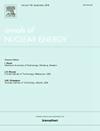Effect of swirling strength on droplets impact on concave wall: Experimental and numerical investigation
IF 1.9
3区 工程技术
Q1 NUCLEAR SCIENCE & TECHNOLOGY
引用次数: 0
Abstract
Droplets impact on walls in a rotating gas–liquid flow field is common in industrial applications. To reveal the effect of swirling strength on droplet impact outcome, droplet trajectory and impingements on the concave wall with three kinds of swirlers are investigated by numerical simulation and experiment. Three impact outcomes are observed: downward slide spreading, horizontal slide spreading, and upward slide spreading. It is found that the swirling strength affects the impact outcome and the spreading factors. The transition from the upward slide spreading to other impact outcomes is promoted by increasing the swirling strength. Moreover, a theoretical model is deduced for the maximum transverse spreading factor of the droplets impact on the concave wall in a rotating gas flow field by modifying the surface energy and adding the auxiliary dissipation. The discrepancies between the predicted maximum transverse spreading factors and the experimental results are in the range of + 5 %∼-10 %.
漩涡强度对液滴冲击凹壁的影响:实验和数值研究
在工业应用中,液滴在旋转气液流场中撞击壁面是很常见的。为了揭示旋流强度对液滴撞击结果的影响,采用数值模拟和实验相结合的方法研究了三种旋流器对凹壁面液滴轨迹和撞击效果的影响。观察到三种影响结果:向下滑动传播,水平滑动传播和向上滑动传播。研究发现,旋流强度影响冲击效果和扩散系数。增加旋流强度可以促进从向上滑动扩展到其他冲击结果的过渡。此外,通过修正表面能并加入辅助耗散,推导出旋转气体流场中液滴撞击凹壁面时最大横向扩散因子的理论模型。预测的最大横向扩散因子与实验结果的差异在+ 5% ~ - 10%之间。
本文章由计算机程序翻译,如有差异,请以英文原文为准。
求助全文
约1分钟内获得全文
求助全文
来源期刊

Annals of Nuclear Energy
工程技术-核科学技术
CiteScore
4.30
自引率
21.10%
发文量
632
审稿时长
7.3 months
期刊介绍:
Annals of Nuclear Energy provides an international medium for the communication of original research, ideas and developments in all areas of the field of nuclear energy science and technology. Its scope embraces nuclear fuel reserves, fuel cycles and cost, materials, processing, system and component technology (fission only), design and optimization, direct conversion of nuclear energy sources, environmental control, reactor physics, heat transfer and fluid dynamics, structural analysis, fuel management, future developments, nuclear fuel and safety, nuclear aerosol, neutron physics, computer technology (both software and hardware), risk assessment, radioactive waste disposal and reactor thermal hydraulics. Papers submitted to Annals need to demonstrate a clear link to nuclear power generation/nuclear engineering. Papers which deal with pure nuclear physics, pure health physics, imaging, or attenuation and shielding properties of concretes and various geological materials are not within the scope of the journal. Also, papers that deal with policy or economics are not within the scope of the journal.
 求助内容:
求助内容: 应助结果提醒方式:
应助结果提醒方式:


